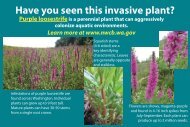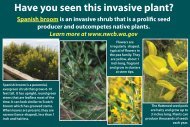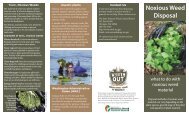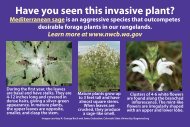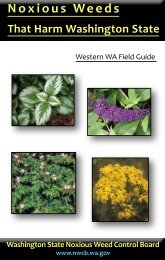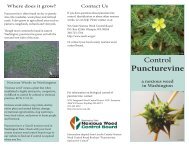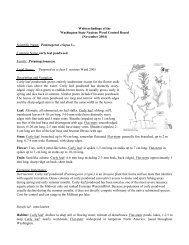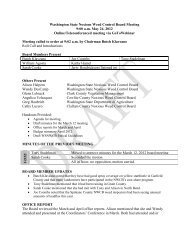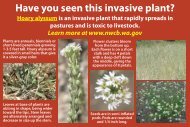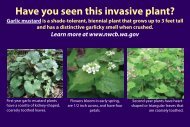Noxious Weeds In Washington State – Noxious Weed Control
Noxious Weeds In Washington State – Noxious Weed Control
Noxious Weeds In Washington State – Noxious Weed Control
Create successful ePaper yourself
Turn your PDF publications into a flip-book with our unique Google optimized e-Paper software.
What are <strong>Noxious</strong> <strong><strong>Weed</strong>s</strong>?“<strong>Noxious</strong> weed” is the traditional legal term forinvasive plants that are difficult to control and aredestructive to <strong>Washington</strong>’s agriculture and naturalresources. <strong>Noxious</strong> weeds include non-nativeinvasive herbaceous plants, trees and shrubs, andaquatic plants. Once established, these invasiveplants can colonize our cropland, rangeland,forests, parks, wetlands, estuaries, and waterways,causing economic and ecological damage thataffects us all in <strong>Washington</strong>. That’s why everyone- homegardeners,farmers,public landmanagers,foresters, andranchers -have a roleto play inthis effort toprevent andcontrol the spread of noxious weeds, such as rushskeletonweed (above).The various impacts of noxious weeds are almostas numerous as the weeds themselves. Althoughthe effects of noxious weeds are often separatedinto economic, environmental, and healthcategories, the three are interrelated. And whilesome noxious weed impacts can be measuredwith a dollar sign, many are too complex to fullycalculate, particularly those affecting natural areas.The floating aquatic noxious weed water primrose (above)clogs waterways and ditches and is costly to control.<strong>Noxious</strong> <strong><strong>Weed</strong>s</strong> Really Hurt UsWhere It Counts: Our Wallets<strong>Noxious</strong> weeds are a problem for all of us, from farmersto urbanites and their impacts cost us, both directly andindirectly. According to a study by the Oregon Dept. ofAgriculture, noxious weeds reduced that state’s personalincome by an estimated $83 million in 2000, and the lossin production caused by these weeds could eliminate anestimated 3,000 jobs per year.Many noxious weeds can significantly reduce propertyvalues. A classic example in the Pacific Northwestis a ranch that sold in auction in 1988 for only about10% of its original worth after becoming overrun withthe noxious leafy spurge (below). <strong>Noxious</strong> weeds arealso costly in suburban and urban areas. For example,invasive knotweeds can grow through pavement, pipes,and septic tanks, causing damage to infrastructure. Andwe all pay for weed control along roadways and utilityright-of-ways, where they reduce visibility and access.Utah <strong>State</strong> University Archive,Utah <strong>State</strong> University, Bugwood.org<strong>Noxious</strong> weeds also cost farmers, ranchers, andorchardists millions of dollars in control efforts and lostcrop production, which can contribute to higher pricesof food for all of us. <strong>In</strong>vasive knapweeds and yellowstarthistle outcompete forage species, reducing grazingquality of rangeland and pastures. <strong>In</strong>festations of thesespecies result in an estimated loss of $950,000 in forageproduction in eastern <strong>Washington</strong>. The cost to providehay to replace the lost forage is an additional estimated$2 million.The majority of forested land in <strong>Washington</strong> iscommercial timberland,and some noxious weedsinterfere with the reforestation process. For example,it was estimated in 2000 that Scotch broom alone costOregon $47 million in reduced timber production everyyear.<strong>Noxious</strong> <strong><strong>Weed</strong>s</strong> Threaten OurNative Plants and EcosystemsWith over 4 million acres of Wilderness Area and120,000 acres of natural areas, <strong>Washington</strong> has beenable to preserve many of its diverse ecosystems.While many pieces of land have been set aside andprotected from development and disturbance, noxiousweeds are still a constant threat. Many of theseinvasive plants adapt to many different environments,and they readily invade our natural areas where theyoutcompete our native vegetation for space, availablesunlight, water, and nutrients. Many noxious weeds formdense monocultures, dramatically reducing biodiversityand often changing the way healthy ecosystems hadfunctioned.Some noxious weeds, such as spotted knapweed, garlicmustard, and several ofthe invasive hawkweeds(right), can exudeherbicide-like chemicalsthat prevent other plantsfrom germinating. So, theynot only make grasslandsand rangelands lesspalatable for grazinganimals by displacingforage species, but theythen make reestablishment of native plants difficult whilethe invasive species are present.Several knotweed species have been invading ourriparian habitat, particularly in western <strong>Washington</strong>.These fast-growing invasive plants can transformriverbanks by restrictingaccess to water,increasing soil erosion,displacing nativevegetation, reducingavailable sunlight, andaltering the nutrientcycle. The degradationof habitat caused bynoxious weeds posea serious threat to our native plants, as well as salmonand other wildlife. And many state endangered andthreatened species such as golden paintbrush andshowy stickseed are displaced by encroaching noxiousweeds such as Scotch broom and Dalmatian toadflax.<strong>Noxious</strong> <strong><strong>Weed</strong>s</strong> ReduceWildlife Habitat<strong>Noxious</strong> weeds can take over native plant communitiesor establish themselves as dominant species where fewplants had been able to grow before. They can changethe habitat upon which our native <strong>Washington</strong> wildlifedepends for food and shelter. Some species such asScotch broom, gorse, knotweeds, Scotch thistle, andHimalayan blackberry form physical barriers that restrictwildlife movement.Purple loosestrife is a well-studied noxious weed thatillustrates how far-reaching the impacts of an invasiveplant can be. This wetland invader forms dense standsand outcompetesnative species,reducing necessaryhabitat for waterfowl,songbirds, smallmammals, andamphibians.Recent studiesare helping us tounderstand waysthat this speciesupsets the foodweb. For example,it may directly harmtadpoles with tannins in its leaf litter. But decompositionof this plant releases different nutrient levels than somenative wetland plants, which affects the types of algaespecies available for the tadpoles to feed on.Many aquatic andwetland noxious weedsdegrade aquatic habitat.For example, the noxiousweed parrotfeatherforms dense mats thatcan choke streams andponds, reduce water flowand oxygen levels inthe water, and displacenative aquatic plantcommunities, which hadprovided valuable habitatfor fish, amphibians,invertebrates, and otherwildlife.L. Scott<strong>Noxious</strong> <strong><strong>Weed</strong>s</strong> AffectRecreational Activities<strong>Washington</strong> <strong>State</strong>’s abundance of pristine landscapesand diverse ecosystems attract many visitors who cometo enjoy our beautiful natural areas and recreationalactivities. <strong>In</strong> fact, about 48 million people visited ourstate and national parks in 2006. <strong>Noxious</strong> weedshave a negative effect on many outdoor activitiesand on tourism, which impacts the livelihood of many<strong>Washington</strong>ians.Rangeland invadersoutcompete the nativeplants that game animalsdepend on. For example,spotted knapweed (right)can reduce the foragequality of areas by up to90% for elk and deer. Thelack of forage forces themto search elsewhere forfood and affects huntingand wildlife viewingopportunities. And noxiousweeds such as knapweeds,knotweeds, and thistlesblock trails and restrictaccess to waterways.Puncturevine is a noxiousweed that is right at home onroad shoulders and trails. Itssharp-spined seeds can rip rightthrough tires, stick to shoes,and really hurt when touched,making it a real nuisance forbicyclists, hikers, and parkvisitors.Aquatic noxious weeds can be problematic for watersports enthusiasts. They limit swimming areas, blockwaterways for boatersand paddlers, and clogboat propellers. Plants likeEurasian watermilfoil (right)can ruin anglers’ favoritefishing spots by degradingfish habitat.Gary KramerSome <strong>Noxious</strong> <strong><strong>Weed</strong>s</strong> are Toxicto People and AnimalsSome noxious weeds are toxic, and in some cases,deadly. The fact that many of these plants rapidlycolonize disturbed areas and spread into neighboringproperties makes them even more troublesome. To learnmore about toxic noxious weeds and how to identifythem, please go to our website, or contact your countynoxious weed control board or WSU extension office.Poison hemlock is a fatally toxic plant to both peopleand animals. It contains the alkaloid coniine, which isa neurotoxin that affects the nervous system. <strong>In</strong> 2010,one person died and severalpeople were hospitalized formistakenly eating or beingexposed to this noxiousweed. Livestock are alsovulnerable, and this cow wasa victim of poison hemlockingestion.Giant hogweed had once been a favorite ornamentalplant, due to its unusually large size.However, contactwith the toxic sapcan leave painful,third-degree burnson the skin thatcan often leavescars.Tansy ragwort is poisonousto cattle, horses, and sheep.It contains alkaloids thataccumulate in the liver,ultimately resulting in chronicliver failure. Unfortunately,many people do not removeit from their pastures,thinking that their animalswill only graze around thenoxious weed. What theydon’t realize is that livestock cannot always avoid eatingthe low-growing and highly toxic rosette leaves, whichcan eventually lead to liver damage.



